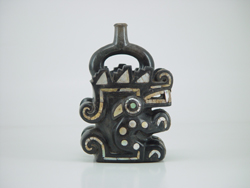Moche Crawling Feline facts for kids
The Moche Crawling Feline is a special type of ancient pot. It was made between the years 100 and 800 CE. This pot comes from the ancient Moche culture in Peru. It looks like an animal, either a "lunar dog" or a crawling cat. You can see this amazing piece at the Larco Museum in Lima, Peru. It was found on the North Coast of Peru.
Contents
The Moche People and Their Art
The Moche people lived in ancient Peru. They were skilled artists, especially with clay. For them, pottery was more than just pots. It was a way to share their beliefs. They used these special pots in important ceremonies. These included rituals for funerals, offerings, and good harvests.
Pottery for Rulers
This specific Moche Crawling Feline pot was found in a tomb. It belonged to a Moche ruler. It was placed there to honor the ruler. People believed it would help them on their journey. This journey was thought to be to the "underworld" after death.
Understanding the Ancient World
Ancient societies in Peru, like the Moche, were mostly farmers. They learned a lot by watching nature. They studied the sky to understand stars, rain, and weather. They observed the earth for farming. They also looked at the world below the ground. This helped them find medicinal plants and roots.
Three Worlds of Belief
The Moche people believed the world had three main parts:
- The Upper World: This was the sky, home to gods. Birds often represented this world.
- The Middle World: This was the earth, where humans lived. Strong animals like felines (big cats) stood for this world.
- The Underworld: This was the world below, linked to death. Reptiles, especially snakes, often represented this mysterious place.
Amazing Ceramic Skills
The ancient people of Peru were masters of pottery. They made incredibly detailed sculptures from clay. They learned this by carefully watching animals and nature. They studied how animals looked and moved. This helped them create very realistic and powerful art.
The Importance of the Feline
Because of their amazing skills, Moche artists could show many details. This helped them express their religious ideas. The feline, or big cat, was a very important symbol. It appeared often in art from Northern Peru. It was a huge source of inspiration for artists. The feline was seen as strong and brave. It was also linked to water and good harvests. This is because big cats often live in wet, fertile areas like the Amazon rainforest.


